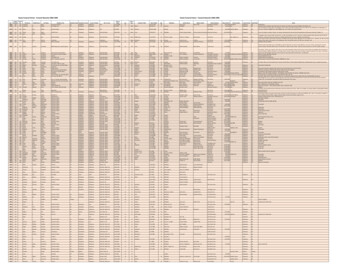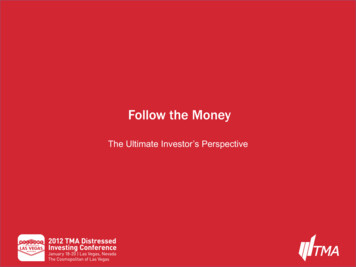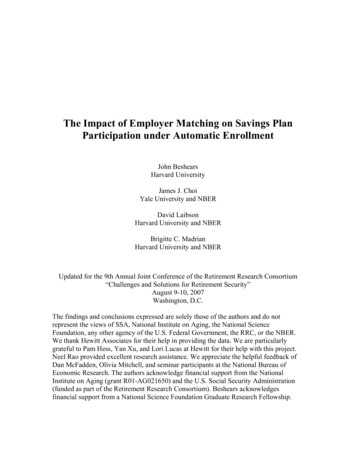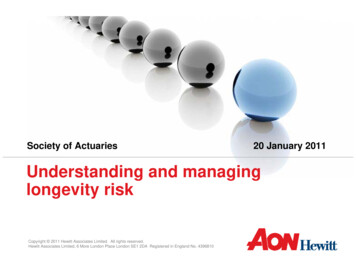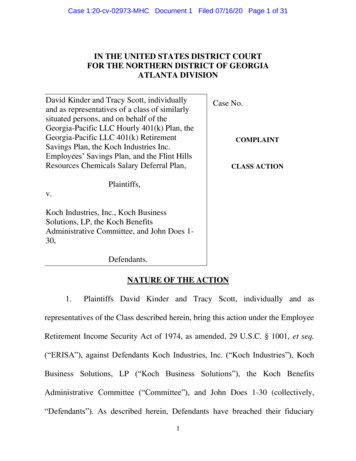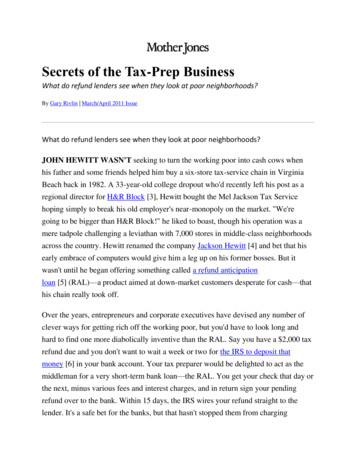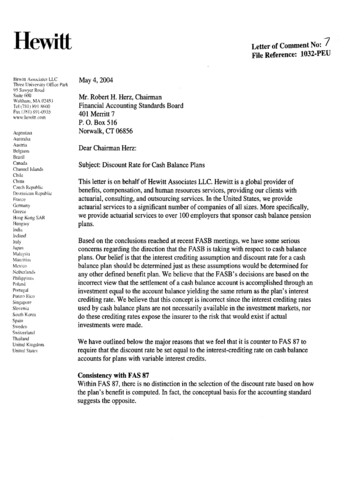
Transcription
HewittA:\'io.;iall !'Hewitt'nlr(' Univer jtyLLCOffl.:c PMk95 Sawv r RoadSuife 660\v llh,\I\J) MA 02453Tel \781) 891-k!'OOFax (7 Ii BelgjumLetter of Comment No: 7File Reference: l032·PEUMay 4, 2004Mr. Robert H. Herz, ChairmanFinancial Accounting Standards Board401 Merritt 7P. O. Box516Norwalk, CT 06856Dear Chairman Herz:BrazilCanadaCbannel IslandsSubject: Discount Rate for Cash Balance PlansChileChioac".et'h RCpHblit.:DCHmnh:anH j')ublj GermanyGreeceHong Kong SARHmtgo.ryIndiaIfoJkmd11;)1 'JapanMah.iys.LtMallrjtilj j\kxiC(\Ncthuland:lPhilipplJ'l(;)Poi(lndPuefl'O RicoSinguporeSloveniaSmlth K0rcaSpainSwc(kn5\\·ifl.erlamJTha.ilandUnited KillgdornLinitedSfJf '!;This letter is on behalf of Hewitt Associates LLC. Hewitt is a global provider ofbenefits, compensation, and human resources services, providing our clients withactuarial, consulting, and outsourcing services. In the United States, we provideactuarial services to a significant number of companies of all sizes. More specifically,we provide actuarial services to over 100 employers that sponsor cash balance pensionplans.Based on the conclusions reached at recent FASB meetings, we have some seriousconcerns regarding the direction that the FASB is taking with respect to cash balanceplans. Our belief is that the interest crediting assumption and discount rate for a cashbalance plan should be determined just as these assumptions would be determined forany other defined benefit plan. We believe that the FASB' s decisions are based on theincorrect view that the settlement of a cash balance account is accomplished through aninvestment equal to the account balance yielding the same return as the plan's interestcrediting rate. We believe that this concept is incorrect since the interest crediting ratesused by cash balance plans are not necessarily available in the investment markets, nordo these crediting rates expose the insurer to the risk that would exist if actualinvestments were made.We have outlined below the major reasons that we feel that it is counter to FAS 87 torequire that the discount rate be set equal to the interest-crediting rate on cash balanceaccounts for plans with variable interest credits.Consistency with FAS 87Within FAS 87, there is no distinction in the selection of the discount rate based on howthe plan's benefit is computed. In fact, the conceptual basis for the accounting standardsuggests the opposite.
HewittMr. Robert H. Herz, ChairmanPageZMay 4, ZOO4It is clear that different designs that result in different projected payment streams couldhave different discount rates (based on the duration of the liabilities). However, there isno basis in FAS 87 for two plans that provide the same projected benefit stream to havedifferent discount rates based on how the bencfits are computed. If a final average payplan had a projected payout of 100,000 in each of the next 10 years and a cash balanceplan had a projected payout of 100,000 in each of the next 10 years, the PBO for thesetwo plans should be identical. There is no more uncertainty in developing the cashbalance payout stream than for the final average pay payout stream.Under the approach FASB favors, the PBO for these two types of plans would bedifferent since the cash balance plan would be required to use an artificially lowdiscount rate equal to the interest crediting rate. FASB's rationale for this distinction isthat the projected cash flow is irrelevant for a cash balance plan. Instead, the FASBappears to believe that an insurance company could accept a payment equal to the cashbalance accounts and invest those assets in an investment that would yield the exactinterest crediting rate for an indeterminate period, with no fluctuation in the principalvalue of the assets. As noted earlier, this type of investment vehicle does not exist.Thus, despite the practical inability to find this "investment" and the inability for it toperform as it would need to if the FASB' s decisions are implemented, cash balanceplans will see the PBO related to the cash balance accounts increase by as much as25 percent from that previously calculated.One of the guiding principles of FAS 87 was to enhance the comparability of thepension expense and disclosure information among employers. The adoption of anapproach like this would reduce that comparability.Investing to Return the Interest Crediting RateWe think it is important to emphasize that the cash balance interest-crediting rate is nota rate that can typically be replicated in the investment markets. If a cash balance planhad an interest crediting rate that was equal to a money market account daily creditingrate (i.e., an account where the principal is fixed, not variable), it would be true that byinvesting the balance in the money market fund, an insurer could then settle theobligations for the amount of the cash balance account. However, this typ of interestcredit is not used in cash balance plans. Further, it is not possible to settle cash balanceaccounts by "locking-in" the interest crediting rate on assets equal to the accountbalances. As a result, these plans must apply the provisions of FAS 87 as other definedbenefit plans are required to do which requires the use of reasonable assumptions and aspecifically determined discount rate.
HewittMr. Robert H. Herz, ChaiImanPage 3May 4, 2004Anomalies of the Proposed ApproachThere are many reasons why it is inappropriate to implement FASB' s proposedapproach. The following examples illustrate some of the anomalies and issues inapplying this approach that would result: Assume that there are two plans that just converted from final average pay formulasto cash balance and that both of these plans have the same opening balances andongoing pay credits. However, one plan uses a one-year Constant Maturity Treasury(CMT) plus 1 percent interest-crediting rate, while the other plan uses a one-yearCMT minus I percent interest-crediting rate. Under FASB's proposed approach,these plans would have the same ABO and PBO (since the sum of their accountbalances would be the same). As time went on, the obligations of these two planswould diverge as actual interest credits caused the balances to grow at different rates.However, during the first few years following the adoption of a cash balance formula,the obligations would look similar and thus the accounting methodology would maskthe real differences between the benefit commitments for these plans. Consider three plans with the same total cash balance accounts and the followinginterest credits: 5 percent, I-year CMT, I-year CMT but no greater than 5 percent.Under FASB's proposed approach, when the discount rate would have otherwisebeen selected to be 6.5 percent, the plan that uses the I-year CMT and the plan thatuses the I-year CMT but not greater than 5 percent interest credits both have thesame ABO and PBO-while the plan with a 5 percent interest credit has a lowerABO and PBO (discount rate exceeds interest credit and plan has a fixed interestcredit). The equality of the ABO and PBO for the J-year eMT interest credits withand without the 5 percent ceiling is illogical, and the lower ABO and PBO for theplan with the fixed 5 percent interest credit relative to a Plan with a 5 percent ceilingon the interest credit can't be explained in any rational way (I.e., the plan with the 1year CMT yield and a 5 percent ceiling will never have an interest credit above5 percent but will typically have an interest credit that falls below 5 percent). Interest credits in cash balance plans are subject to minimums, maximums, annuallimits on increases, annual limits on decreases, and also can vary with equity indices.In addition, many of these plans provide the greater of cash balance or final averagepay benefits. How would a plan sponsor apply the discount rate to this "better of' thetwo benefits design?
HewittMr. Robert H. Herz, ChainnanPage 4May 4, 2004As you can see, we are confused by the rationale for an approach that would set thediscount rate equal to the interest-crediting rate. We believe that it is a step backwardsfrom the intent of FAS 87 to provide comparability in infonnation. The infonnation isno longer comparable when reviewing financial infonnation for cash balance plansversus the same infonnation for other defined benefit plans. Nor is there comparabilitywhen considering the financial infonnation for fixed interest and variable interest creditcash balance plans.The premise for this accounting is that there are investments that mirror the interestcredits. This is a fundamentally flawed premise and clearly fails to consider otherimportant plan design infonnation. As actuaries for over 100 cash balance plans, wewould be happy to share infonnation with FASB which we believe will support theinappropriateness of this proposed approach.Review Before Modifying FAS 87We and others asked FASB to give this cash balance accounting further review when ithad looked like FASB was ready to adopt this position along with confinning thedefined benefit nature of cash balance plans and specifying the attribution method forfixed interest rate plans (in EITF 03A). We had expected that when FASB studied thistopic it would be impossible to conclude that the proposed approach made sense. If theonly explanation for the proposed approach is that the interest credit can be achieved inthe market place as it is defined in the plan and without any adverse market risk, thenthe basis for FASB' s conclusions is without merit.Although we have heard FASB support this proposed approach with the investmentexplanation to which we expressed our concerns in prior sections of this letter, we alsosuspect that FASB is reacting to the fact that this interest crediting rate is a financialassumption. Through FAS 87, the additional disclosures regarding the expected rate ofreturn on assets and other guidance. FASB is defining the other major financialassumptions (discount rate and expected return) to be more "cook-book" driven (i.e.,less input from the professionals who typically make long tenn assumptions and morereliance on benchmarks). To the extent that a reluctance to allow plan sponsors, withassistance from their actuaries, to make reasonable assumptions regarding financialvariables is driving FASB's position, the use of a discount rate equal to the interestcrediting rate is the wrong answer.
HewittMr. Robert H. Herz, ChainnanPage 5May 4, 2004The expected rate of return on plan assets is built from different assumed returns fordifferent asset classes. Since a bond portfolio is typically a component of the expectedrate of return and most cash balance plans use Treasury based yields to detennine theinterest credit, the expected rate of return already includes a component for theseinterest crediting rates. Instead of mandating an approach that produces inconsistentresults, the FASB should be promoting an approach that recognizes the consistencybetween the interest crediting rate and the expected rate of return on assets and allowsplan sponsors, with assistance from their actuaries, to make reasonable and consistentassumptions regarding the interest crediting rates.The proposed requirement will have a huge impact on the accounting for plan sponsorsof cash balance plans and is contrary to universally accepted approaches for pastaccounting. We ask that FASB reconsider its position that the discount rate should beset equal to the interest crediting rate.We would be glad to provide additional infonnation to the FASB and would be glad todiscuss any issues with you. You can contact me directly by phone at (781) 314-7647.Sincerely,Hewitt Associates LLCJeffD. ClymerJDC:srnrDelivered via email
Hewitt Hewitt A:\'io.;iall !' LLC 'nlr(' Univer jty . had an interest crediting rate that was equal to a money market account daily crediting . (i.e., an account where the principal is fixed, not variable), it would be true that by investing the balance in the money market fund, an insurer could then settle the obligations for the amount .
